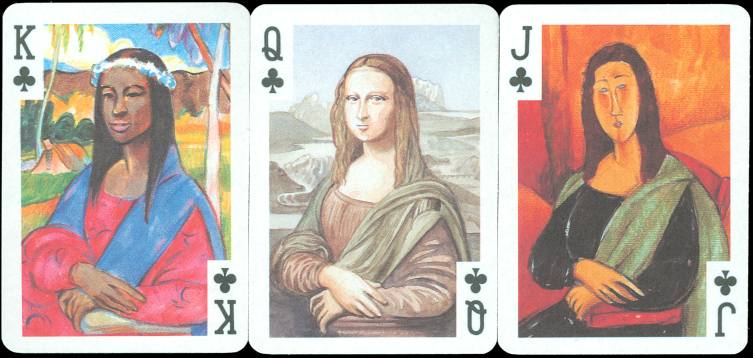March 2010
We can't complain
about the number of decks to choose from this month. Problem this month was that
they were hard to compare. Not only because there was a great variety in topic
and layout, but also because in some of them we had a special interest. On the Dutch auction site we
found a deck from the series of pictorial decks that were printed and published
by Fournier between 1955 and 1962 as souvenir decks for: Spain, Kenya, Egypt,
Paris, Italy, Denmark and Lebanon. We have the first four decks and had
seen the last and somewhat harder to find deck a few times on Ebay. But even
though we had bid generously, we were outbid every time. So it was somewhat
special to find it at a bargain price only 10 miles away.
The other interesting
deck was found during the general collectors fair in Utrecht. It was a curious
publication, as it had the dimension and looks of a pocketbook. Inside however
was a sliding box with large cards. The deck was printed and published in the
Czech Republic as "Hraci Karty Karetny Hry" in 1969. Translated it
means "Playing Cards Card Games". But the surprise was that it didn't
only look like a book, but actually was one too. On the courts there were images
of antique playing cards and text, the pips only had text on them. But there was
a different text on each of the backs too and when put in the right order, the
deck makes a 108 paged book, written by Vojtech Omasta and Slavomir Ravik. The 2
jokers carry the title sheet and the preface. We translated a few of the chapter
titles and it seems to be about the history of playing cards and certain card
games. On the title card it says "1. dil", so there might be a second
volume too. Although the content is in Czech and we'll probably never know
what it says, it's the most original book about playing cards that we've ever
seen.
 |
Both these
decks had a good reason to be put in the spotlight here. But we've
chosen another one. First of all because it shows a highly authentic way
to present a classic among the classics. But secondly because, although
we don't know when the deck was published, it might be one of the
last editions by Naipes Comas from Spain. Last month this playing card
manufacturer, who had been in business for over 2 centuries, was taken
over by Carta Mundi from Belgium. The production of playing cards will
be transferred to Turnhout and 15 employees of Naipes Comas will be
fired. In its long history the company has published many beautiful
decks, among which the Dali Tarot deck was one of the latest. So, as an
homage to Naipes Comas here, we're happy to present this "art"
deck......... |
The deck consists of 52 cards and 2 cards,
which can be used as jokers, but are named "El AutÚntico". The
authentic one here is the Mona Lisa by Leonardo da Vinci. And although there
will only be a few people who won't recognize the original Mona Lisa, it's a
nice introduction to the non-standard courts in the deck.
Each of the courts
shows the Mona Lisa as it could have been painted by an other famous artist. We
thought it was a very original way to address a classic painting like the Mona
Lisa and we had fun putting names of artists to the different versions. We
haven't been able to recognize all of them, so if anyone could fill the blanks
we'll add their names here.
|

|
| George MONET |
Pablo PICASSO |
unknown EGYPTIAN |
|

|
|
Salvador DALI |
Utagawa HIROSHIGE |
|

|
| Paul GAUGUIN |
|
Amadeo MODIGLIANI |
|

|
|
Fernando BOTERO |
|
The deck was
published to promote Velmonit, a brand name used by Bayer in Spain for
ciprofloxacin. This chemotherapeutic antibiotic kills bacteria such as
anthrax.

The deck has
plain aces, so we only show the two 4's here. It's a nice Spanish tradition to
put the name of the manufacturer on one of the 4's, but we're afraid that after
213 years the name of Comas won't be printed on playing cards anymore. Another
major playing card manufacturer that has been eaten up by Carta Mundi ! It's
probably Carta Mundi's main course for 2010......... an Indian manufacturer will
be served as dessert later this year. After a few years of major takeovers Carta
Mundi is beginning to live up to it's name: "Cards of the World".
So.... here's a farewell to another "autÚntico"!
It seems that the
deck was published in 1995. However, that doesn't change the fact that we like
to salute this Spanish manufacturer and his rich history in playing cards.
BACK TO PRESENT MONTH





